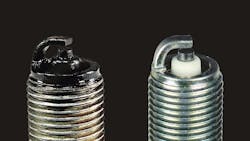The spark plug has a straightforward job to do. It’s responsible for igniting the air/fuel mixture in the engine’s combustion chamber initiating the power stroke. But this task is far from simple. The spark plug’s operating environment is extreme with combustion temperatures reaching 1500 F and peak cylinder pressure reaching 1,000 psi or more.
But because the spark plug is located inside the combustion chamber it can supply important insight into the inner workings of the engine when we remove it.
The spark plug is designed to use the ignition coil’s energy to generate the spark inside the combustion chamber. This spark creates the flame kernel and starts the combustion event. The flame development, which takes place at the tip of the spark plug inside the engine's cylinder is complicated enough, and that’s even before we add the extra complexities of GDI, high swirl combustion chambers and turbochargers/superchargers.
If the kernel does not form properly, or if it’s extinguished before allowing flame propagation, the result could be a cylinder that misfires. But a failed spark kernel formation is not the only thing that can cause an ignition misfire event. Worn, fouled, contaminated or mechanically damaged spark plugs can also result in a misfire.
The old ways of reading a spark plug and relating the look of the spark plug’s insulator and electrodes to the engine’s air/fuel ratio, ignition timing and engine condition seem to have gone away like the carburetor and distributor. But that doesn’t mean we still can’t use and interpret what a spark plug is telling us about what is happening inside the engine’s combustion chamber — a place we can’t easily see.
Normal operation
The air/fuel mixture on today’s engines is almost at stoichiometric values immediately after the engine starts. The ignition timing is carefully adjusted to maintain the maximum advance without crossing into the area of detonation or pre-ignition. This combination of consistent air/fuel ratio and ignition timing results in spark plugs that will show little wear even after years and many miles of use. The results of these optimal running conditions will show up on the spark plug’s porcelain as a dull gray color, or reddish color depending on the seasonal fuel blend being used. Often the spark plug will show a slightly darker color to the porcelain, but that is usually only because the engine wasn’t at full operating temperature when the spark plug was removed. (It’s important to follow the manufacturer’s recommendations on spark plug removal and installation to prevent any cylinder head damage.) Today’s precious-metal spark plugs will show little if any wear, but the traditional copper or non-precious metal spark plug may show slight rounding of the electrodes due to erosion, which is normal and to be expected.
Engine/mechanical issues
Oil deposits on the spark plugs that are caused by excessive oil in the combustion chamber can result in a random spark plug misfire, or if the issue is left unresolved long enough, a complete failure of the spark plug in a particular cylinder and a steady misfire. Oil deposits begin as a black shiny deposit at first, and the plug may even smell like engine oil when removed. But if the deposits on the spark plug are left long enough or the oil consumption is extreme, the spark plug may turn a whitish, sooty-color in appearance.
Oil fouling of spark plugs on high mileage or poorly maintained engines can be expected, but even well-maintained engines can suffer from excessive oil consumption caused by engine designs and functions. High engine vacuum generated by cylinder deactivation and variable valve timing can pull engine oil past the piston rings and into the combustion chamber. This has been a common concern for some manufacturers. Once the oil enters the combustion chamber it can become carbonized, depositing on the spark plug, piston head and fouling the piston rings, accelerating the oil consumption issue.
But there are other issues that can cause a spark plug to become oil fouled:
- a failed or failing PVC system;
- turbocharger shaft sealing issues;
- using the incorrect engine oil; and
- internal engine wear.
These can all be causes of excessive engine oil entering the combustion chamber.
Coolant entering the combustion chamber can also cause spark plug deposits. Coolant will typically show on a spark plug as a white deposit that will be ashy in appearance and feel — but this is only if the coolant leaking into the combustion chamber is caught in the earliest stages. And, the white, ashy coloring can easily be mistaken for oil fouling.
On the extreme end of coolant entering the combustion chamber, the spark plug will be totally cleaned of all deposits and look new and wet. This type of spark plug issue can be limited to one cylinder, mating cylinders or the entire engine depending on the source of the coolant leak. Coolant that enters a combustion chamber can also result in the spark plug’s insulator cracking and breaking due to the thermal shock of the coolant contacting the hot insulator surface.
Coolant in the combustion chamber isn’t the only cause of physically broken spark plug insulators or electrodes; detonation and pre-ignition (two separate phenomena) are often to blame for this condition. These two conditions can show up on the insulator of the spark plug as small black specks of carbon from incomplete combustion, or shiny specks of material blasted from the actual piston surface, if the condition is caught soon enough. These tiny specks are the result of the unintentional explosion of the air/fuel mixture in the combustion chamber and the resulting shockwave that is created.
Persistent cylinder detonation may show up on a spark plug as a cracked, chipped or broken insulator and possibly as electrode damage as well. While prolonged pre-ignition can cause a melted center, ground electrode and possible insulator damage as well, neither situation is good, and it needs to be rectified before new spark plugs are installed.
Fuel issues
Carbon fouling caused by rich fuel mixtures will usually appear as a flat, black, soft-feeling deposit that will cover the entire insulator and electrode parts of the spark plug. If there is a severe over-fueling issue the spark plug can be black, wet and smell of raw fuel. These carbon fuel deposits are the results of partially burned fuel sticking to the hot spots (the spark plugs) in the combustion chamber. The causes of the over-fueling are numerous: weak ignition output, fuel injector issues and fuel control sensor issues (MAF, temperature sensors and Oxygen or air/fuel sensor concerns). But there is another common cause of carbon fouling: restricted air flow.
Excessive carbon buildup on the intake valves can restrict the airflow into the combustion chambers. This intake valve carbon restriction can cause turbulence in the combustion chamber that can affect spark kernel growth and flame propagation resulting in improper combustion and carbon deposit formation.
Lean fuel conditions can cause dangerous pre-ignition that can melt the center/ground electrode and may even cause engine damage. Common causes of the lean fuel condition are fuel control sensor failure, EGR issues, incorrect spark plug application and ignition timing/knock control concerns.
Corona soiling…normal
What causes the discoloring of the outside of the ceramic insulator near the metal part of the spark plug? And, is it an issue?
Called corona soiling, this condition is caused by the intense magnetic field created in the spark plug when the ignition coil discharges. The resulting magnetic field attracts tiny amounts of dirt/debris that bond to the ceramic surface. Corona soiling is often confused with a spark plug that is leaking combustion gases, but that is not the case, and this condition is normal. But this shows the importance of proper spark plug installation and the need for clean surfaces when performing spark plug service.
Technician error
We’re quick to blame any misfire problem on a defective spark plug, especially if we just replaced them. Simply dropping a plug, possibly closing the gap or causing unseen damage during installation is quite common. When you pick up that dropped spark plug should it be used? The short answer is no. It could have suffered non-visible internal damage. It could have a hairline crack that is not visible but will lead to premature failure. A closed gap can’t be accurately re-gapped without risking damage on fine-wire or precious-metal tipped plugs.
Using an air ratchet or other power tool can easily crack or damage a spark plug during installation. Many times, the damage goes unnoticed until the vehicle returns with a Service Engine Light on, or a misfire complaint.
Careful hand installation and the use of a torque wrench is always recommended by spark plug manufacturers because over and under torquing can easily create a misfire situation. Plugs that are over-torqued can become distorted. The housing can stretch and the insulator can crack.
Damaged plugs can also damage the cylinder head or even break off. Insufficient tightening can lead to spark plug overheating due to improper heat transfer or escaping combustion chamber gases. That can, in turn, damage the coil assembly or the attached ignition wire.
Not just any spark plug will work anymore
Spark plugs have certainly changed over the years, and today’s engines are designed to work with a specific spark plug. Spark plugs must meet manufacturer specifications for durability, performance characteristics, and to match the engine’s ignition and fuel delivery systems. GDI and turbocharged engines are particularly sensitive to the proper spark plugs being installed.
On most GDI engines, the fuel injectors spray directly at the spark plug to increase combustion efficiency. On turbocharged or supercharged engines, high swirling vortices put tremendous pressure on the spark plugs to ignite the mixture properly. The kernel can literally be blown out or quenched by the fuel spray or combustion chamber turbulence. This has led to different tip designs, styles, and even indexed plugs to maximize the ignition performance.
Though they still perform the same function, their design and operating requirements have changed dramatically. With today’s engine management systems, direct fuel injection, high power ignition systems, precious metals and meticulously designed spark plug tip and electrode designs, the life of a spark plug can easily reach the lifetime of the vehicle.
About the Author

Jeff Taylor
Jeff Taylor is a seasoned professional at CARS Inc. in Oshawa with 40 years in the automotive industry. As a skilled technical writer and training developer, he holds licenses in both automotive and heavy-duty vehicle repair. Jeff excels in TAC support, technical training, troubleshooting, and shaping the future of automotive expertise.
